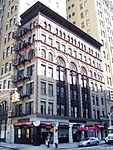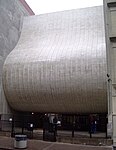Pearl River Mart
1971 establishments in New York CityBroadway (Manhattan)Retail companies based in New York CityUse mdy dates from July 2019
Pearl River Mart is an Asian-American retail brand and family-run business in New York City. The business was founded in 1971 in Chinatown, Manhattan, as Chinese Native Products by Ming Yi Chen and a group of student activists from China, Hong Kong, and Taiwan. Chen has said that she and her colleagues "wanted to create a small window into the Chinese culture". Its products include braided straw slippers, paper lanterns, cheongsams, cotton Mary Janes, and copies of Mao's Little Red Book. Pearl River Mart has become a New York City institution. The business has an art gallery in its main location, and hosts in-store events and performances.
Excerpt from the Wikipedia article Pearl River Mart (License: CC BY-SA 3.0, Authors).Pearl River Mart
Broadway, New York Manhattan
Geographical coordinates (GPS) Address Nearby Places Show on map
Geographical coordinates (GPS)
| Latitude | Longitude |
|---|---|
| N 40.7182 ° | E -74.0028 ° |
Address
Broadway 384
10013 New York, Manhattan
New York, United States
Open on Google Maps









